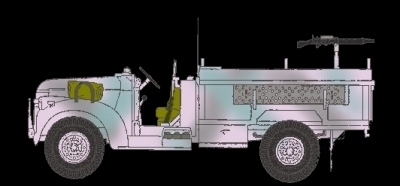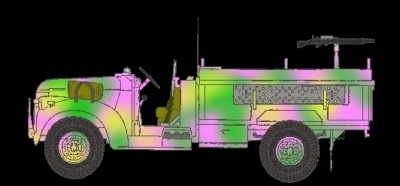LRDG
Vehicles and Equipment - Patrol Structure and Camouflage
Overview / Patrol Cars / Heavy Section/Royal Artillery / Weapons and Equipment / Patrol Structure and Camouflage Schemes
On this page: Patrol Structure / Vehicle Names
/ Camouflage Patterns
Patrol Structure
Upon inception of LRDG in August 1940 (the unit was actually called LRP (Long Range Patrol) at that time), the unit consisted of a HQ staff, Heavy Section (which was called "Marmon Herrington Party" until being renamed in December) and three patrols:
- R Patrol (New Zealand)
- T Patrol (New Zealand)
- W Patrol (New Zealand)
In December, 1940, W Patrol was disbanded due to most of its members being relocated to Greece, and LRP was reorganised and subsequently renamed LRDG. In the process of reorganisation, a new Patrol was added in December and two more in January for the final makeup of five patrols:
- G Patrol (Coldstream Guards, added December 1940)
- R Patrol (New Zealand)
- S Patrol (Rhodesians)
- T Patrol (New Zealand)
- Y Patrol (Yeomanry)
Summer 1941 saw the addition of a temporary H Patrol to take up the remainders of the heavily battle-scarred Y and G patrols, which both were subsequently reformed. At the same time, a number of sections (Signals, Air, Survey, Light Repair and the short-lived Royal Artillery) were attached to HQ.
LRDG's Patrols were subsequently reorganized into two half patrols (Autumn 1941), the various sections attached to HQ were restructured several times (most notably, Light Repair was promoted to a squadron in 1941, Air and Survey Sections were merged into one section in 1942). Late in 1942, LRDG had another short-lived subsection called the "No.1 Demolition Squadron"; this squadron soon left LRDG and followed their own path under the name "Popski's Private Army".
back to top
Vehicle Names
All LRDG patrols had a tradition of giving each of their trucks an individual name; these names were so well established that trucks were regularly referred to by their names not only in everyday conversation and LRDG members' memoirs, but also in official paperwork where official identification numbers should be expected. As a result, it is difficult to establish a connection between vehicle license numbers and names where no photographic evidence exists.
The three New Zealand Patrols used to give all their vehicles Maori names that started with the respective patrol's identification letter. Some examples are:
- R Patrol: Rotoma, Rotowari, Rotokawa, Rotowhero, Rotoroa
- T Patrol: Te Anau, Te Rangi, Taipo, Tutira
- W Patrol: Waikaha, Waima, Waitoma, Waiariki
If a vehicle was lost, the name was sometimes reused; in such cases a number was added for clear identification (Te Rangi II, Te Anau II)
Y Patrol seems to have preferred more classical names; the vehicles of Y2 patrol were given names from the "Three Musketeers" (Aramis, D'artagnan etc.). Other vehicles of Y Patrol carried more British names like "Cock O'The North".
The trucks of Heavy Section followed the scheme of using only names that started with 'H'; known names include "Hermes", "Hippo", "Hector" and "Hercules".
At the moment, I do not have any information on the naming conventions of G and S Patrol; any input appreciated.
back to top
Camouflage
Patterns
Note: Much of the information in this section is somewhat conjectural, hard evidence on exact colors used seems to be impossible to find. If anyone has had more luck than me with finding exact color references, please let me know.
With some minor exceptions (listed below), all vehicles used by LRDG were specially ordered for the Group; it seems there were no stray imports from other parts of the army into LRDG's regular vehicle pool. It can be safely assumed that all these vehicles received a standard factory paint job in light sand (best guess seems to be Light Stone 61, thanks to Hanno Spoelstra for that information); this paint job usually included areas such as the chassis and the inside of the engine compartment. Exceptions to this rule of thumb are:
- The small number of Chevrolet WBs that were acquired from a local Chevrolet dealer when the Group was formed. I have not found any information on the original color of these trucks or on subsequent repaints.
- Various captured Italian trucks (most notably Fiat AS37 and Lancia 3RO) that were temporarily used by Heavy Section. I assume that these trucks retained their original Italian paint job (usually uniformly painted in a light sand, a bit darker than the British sand color).
- The small number of 8th Army vehicles (an M3 Stuart tank and a White halftrack) that were given to LRDG to test their desert performance. Information on these vehicles is generally as good as impossible to find; as they both failed to meet the Group's requirements after very short evaluation periods, it can be assumed that both kept their original paint jobs.
Once vehicles were employed by LRDG, there was no official policy for camouflage schemes. Patrol commanders were allowed to paint their trucks in whatever color scheme they saw fit with whatever paint was available at the moment (some repaints apparently were carried out by local paint shops, so obviously some of these paint jobs did not even use official Army colors). Additionally, colors quickly faded in the intense sunlight of the African desert; as a result, it is safe to assume that a great deal of variation in actual vehicle colors existed. Some of the more common camouflage schemes included:
- A hard-edged splinter camouflage in a darker grey (possibly Light Battleship Grey 31), most often employed by T Patrol, but also sometimes seen on vehicles of R Patrol (for an example, see here).
- A random spray of light pink/light blue, apparently also used by T patrol, but also sometimes talked about with reference to G Patrol trucks.
- A random spray of very flashy pink, yellow and green, for a time used by G Patrol. This color scheme apparently was very bright when applied, but the effects of sunlight and several layers of dust would quickly tone down the colors.
These images give an approximation of how the various camouflage schemes mentioned above might look like on a 1533 Chevy:
A very interesting quote on color schemes (and especially on the flashy scheme used by G Patrol) can be found in Timpson's book "In Rommel's Backyard":
"Considerable latitude was given to Patrol commanders [...] in the methods of camouflaging their equipment. In the last respect "G" Patrol adopted an original colour scheme. We took each of them off in turn to a helpful paint shop where it was sprayed the most glorious pink, yellow and green. If they did not elude detection from enemy aircraft they would at least dazzle them. When first sprayed, they did look a little flashy. Corporal Inwood [...] said he would not be seen in Cairo driving such a thing, but discipline overcame embarassment. [...] I assured my troops that the colours would soon tone down and that the trucks would become as good as chameleons eventually."
(Alaistair Timpson, In Rommel's Backyard, Leo Cooper 2000, Page 78)
back to top
Previous Page / back to top /
back
to main page / back to main page
(no frames)







